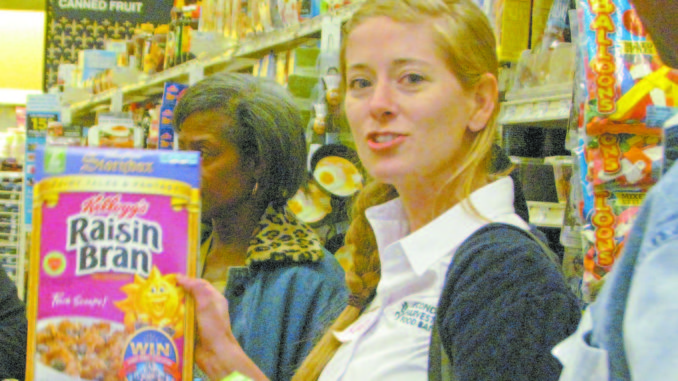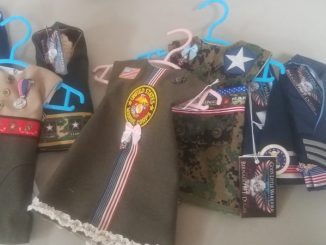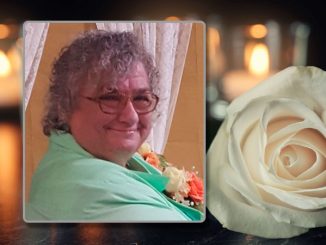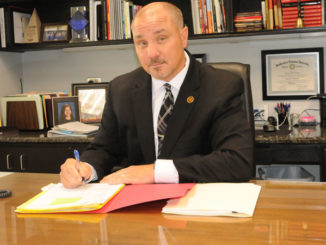
Pantries, services unite to provide food and guidance on nutrition, cooking, shopping and even reading labels
With every bag of food given to those in need at the Matthew 23:35 Food Pantry, Mary Anne Schindler kept thinking about ways to help those in need help themselves even more.
And that’s when the help started coming – and it kept on coming.“This has blossomed so much,” Schindler said. “I tell people over and over again – it’s miracles.”
The food bank started at the St. Charles United Methodist Church in Destrehan with asking the congregation to bring in food that volunteers put in bags and the secretary would hand them to people.
In the two years since Schindler volunteered to come on as coordinator, the pantry has quickly evolved into a effort that provides the food, but also teaches people how to get the most from it and as nutritionally as possible.
While the pantry had been operated quite a while, it wasn’t until about a year ago that it really took off when the church partnered with Second Harvest Heartland, a national food bank based in Minnesota.
It is also a member of Feeding America, a network of more than 200 food banks in the United States with access to million of pounds of surplus food and grocery donations.
A distribution that once averaged 10 to 15 families has ballooned to nearly 200 families served every Wednesday at the church.
“It is mindboggling how much used to go to the dumpster,” Schindler said of food now coming from Winn-Dixie in Destrehan and into food bags.
This is where a lot of Matthew 23:35 Food Pantry’s food comes from, as much as hundreds of pounds of food a day, making it possible to assist many more people.
“Now they know us and see what we’re doing they’re giving us the food a lot faster,” she said. “We’re getting stuff now that isn’t expired.”
Sometimes the food comes from a broken case or removing one bad orange in a bag or even fresh bananas from over ordering.
What food comes changes constantly, but rarely who and how much it helps.“It could be your neighbor,” Schindler said. “The seniors are still coming, but a lot of people coming – it’s a one-parent household. It’s common to see seniors raising their grandchild or grandchildren. They’re living on Social Security or retirement and, all of a sudden, they’re raising children again.”
Fortunately, as the need grows, so do the community volunteers willing to pick up the food, bag and distribute it. Some people even leave bags of food anonymously, while one time she met a donor that she had nicknamed, “the peanut butter angel,” because his bags always included two jars of the stuff.
Some have questioned whether this effort is getting too big to handle, but Schindler just stays focused on feeding families and help comes.
“Every time we think we can’t get to the next step, something happens that brings us there,” she said.
This time it came with the St. Charles Parish Library and Community Services for St. Charles Parish, which together developed a demonstration to help food recipients learn how to make the most of what they get from Second Harvest and the church pantry.
“We believe that to solve hunger we must not only provide food, but provide access to accurate nutrition information and food budgeting education. We work to empower pantry clients to provide their families and themselves with nourishing food and a healthy lifestyle,” said Karen Gardner, Second Harvest Food Bank’s community nutrition specialist.
Joan Diaz agreed and wanted to help.
As community services director with St. Charles Parish, Diaz works with Second Harvest on a crisis basis and then routes people with ongoing food needs to partners like the Matthew 23:35 Food Pantry.
Diaz distributes 55 food boxes a month, averaging about 200 clients. They are typically single parents, seniors and some struggling families recently unemployed.
Matthew 23:35 Food Pantry along with Second Harvest, Diaz and the St. Charles Public Library recently held their first
“Cooking Matters” demonstration, with assistance from the St. Charles Library, showing clients how to cook healthy meals with the items they get from the food banks.
Diaz said they cooked turkey jambalaya, veggie pasta, dump cake with apples and made fruit smoothies.
They also were taught how to read food labels and how to shop. Schindler said a surprising number of people don’t know what a lentil is or how to cook the legume so they’d return them.
“This demonstrates how you can be creative with the food available to you,” said of an event that drew 13 people determined to learn self-sufficiency and maximum use of resources. “We hope to see this as an ongoing partnership.”
Stepping up efforts to help those in need certainly is becoming more important as the need continues growing.
“In the beginning, it was almost all senior citizens we were serving,” Schindler said. “We don’t give enough food to sustain them, but we give them food to help make ends meet. But, lately, I’ve seen a lot more younger families, single families and now it’s gotten to be all ages, all ethnic groups – people from all parts of the parish.”




Be the first to comment